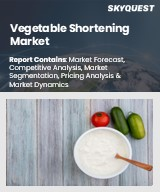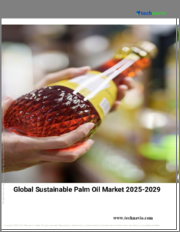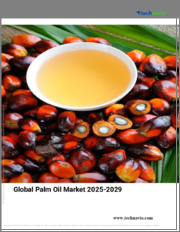
|
시장보고서
상품코드
1607721
팜유 시장 규모, 점유율, 성장 분석 : 성질별, 제품별, 최종 용도별, 지역별 - 산업 예측(2024-2031년)Palm Oil Market Size, Share, Growth Analysis, By Nature (Organic, Conventional), By Product (CPO, RBD Palm Oil), By End Use, By Region - Industry Forecast 2024-2031 |
||||||
세계 팜유 시장 규모는 2022년 653억 달러로 2023년 693억 달러에서 2031년에는 1,032억 달러로 성장할 것으로 예상되며, 예측 기간(2024-2031년) 동안 5.1%의 CAGR로 성장할 것으로 예상됩니다.
팜유는 주로 말레이시아와 인도네시아의 열대 야자수에서 추출되며, 높은 수율과 경쟁력 있는 가격으로 인해 전 세계적으로 수요가 급증하고 있습니다. 지난 30여 년 동안 농업 공동체에서 많은 고용을 창출해 왔습니다. 독특하게도 팜유는 트랜스지방산이 거의 없어 소비자들에게 매력적인 선택이 되고 있습니다. 비스킷, 마가린, 빵, 인스턴트 라면, 시리얼, 립스틱, 샴푸와 같은 퍼스널케어 제품, 양초, 세제와 같은 생활용품 등 다양한 제품에 활용되고 있습니다. 이러한 다양한 애플리케이션 포트폴리오는 시장성을 높일 뿐만 아니라 생산량을 크게 증가시켜 팜유가 전 세계에서 가장 널리 사용되는 식물성 기름 중 하나로 자리매김하고 있습니다.
목차
소개
- 조사 목적
- 조사 범위
- 정의
조사 방법
- 정보 조달
- 2차 데이터와 1차 데이터 방법
- 시장 규모 예측
- 시장 가정과 제한
주요 요약
- 세계 시장 전망
- 공급과 수요 동향 분석
- 부문별 기회 분석
시장 역학과 전망
- 시장 개요
- 시장 규모
- 시장 역학
- 성장 촉진요인과 기회
- 성장 억제요인과 과제
- Porters 분석과 영향
- 경쟁 기업 간의 경쟁 관계
- 대체품의 위협
- 구매자의 교섭력
- 신규 참여업체의 위협
- 공급 기업의 교섭력
주요 시장 인사이트
- 주요 성공요인
- 경쟁 정도
- 주요 투자 기회
- 시장 생태계
- 시장 매력 지수(2023년)
- PESTEL 분석
- 거시경제 지표
- 밸류체인 분석
- 가격 분석
- 기술의 진보
- 규제 상황
- 사례 연구
- 특허 분석
- 무역 분석
팜유 시장 규모 : 성질별·CAGR(2024-2031년)
- 시장 개요
- 유기농
- 기존
팜유 시장 규모 : 제품 유형별·CAGR(2024-2031년)
- 시장 개요
- CPO
- RBD 팜유
- CP6
- CP8
- CP10
- 팜핵유
- 분별 팜유
팜유 시장 규모 : 최종 용도별·CAGR(2024-2031년)
- 시장 개요
- 식품 및 음료
- 퍼스널케어·화장품
- 바이오연료·에너지
- 의약품
- 기타
팜유 시장 규모·CAGR(2024-2031년)
- 북미(성질, 제품, 최종 용도)
- 미국
- 캐나다
- 유럽(성질, 제품, 최종 용도)
- 영국
- 독일
- 스페인
- 프랑스
- 이탈리아
- 기타 유럽
- 아시아태평양(성질, 제품, 최종 용도)
- 중국
- 인도
- 일본
- 한국
- 기타 아시아태평양
- 라틴아메리카(성질, 제품, 최종 용도)
- 브라질
- 기타 라틴아메리카
- 중동 및 아프리카(성질, 제품, 최종 용도)
- GCC 국가
- 남아프리카공화국
- 기타 중동 및 아프리카
경쟁 정보
- 상위 5개사의 비교
- 주요 기업의 시장 포지셔닝(2023년)
- 주요 시장 기업이 채용한 전략
- 시장의 최근 동향
- 기업의 시장 점유율 분석(2023년)
- 주요 기업 개요
- 기업 개요
- 제품 포트폴리오 분석
- 기업 부문별 점유율 분석
- 매출 전년비 비교(2021-2023년)
주요 기업 개요
- IOI Group Berhad(Malaysia)
- Wilmar International Limited(Singapore)
- Sime Darby Plantation Berhad(Malaysia)
- Kuala Lumpur Kepong Berhad(Malaysia)
- Golden Agri-Resources Ltd.(Singapore)
- Musim Mas Group(Indonesia)
- Cargill Inc.(United States)
- Archer Daniels Midland Company(United States)
- Bunge Limited(United States)
- Louis Dreyfus Company(Netherlands)
- Astra Agro Lestari Tbk PT(Indonesia)
- United Plantations Berhad(Malaysia)
- PT Smart Tbk(Indonesia)
- IOI Loders Croklaan(Netherlands)
- Godrej Agrovet Limited(India)
- Asian Agri(Indonesia)
- Olam International Limited(Singapore)
- IOI Oleochemical Industries Berhad(Malaysia)
- Felda Global Ventures Holdings Berhad(Malaysia)
- Genting Plantations Berhad(Malaysia)
결론과 제안
ksm 24.12.27Global Palm Oil Market size was valued at USD 65.3 billion in 2022 and is poised to grow from USD 69.3 billion in 2023 to USD 103.2 billion by 2031, growing at a CAGR of 5.1% during the forecast period (2024-2031).
Palm oil, derived from tropical palm trees predominantly in Malaysia and Indonesia, has seen a surge in global demand, fueled by its high yield and competitive pricing. Over the past three decades, it has generated substantial employment within agricultural communities. Uniquely, palm oil boasts low to zero trans-fats, making it an appealing choice for consumers. Its versatility spans a wide array of products, including biscuits, margarine, bread, instant noodles, cereals, personal care items like lipsticks and shampoos, as well as household goods such as candles and detergents. This diverse application portfolio not only enhances its marketability but also drives significant production increases, solidifying palm oil's status as one of the most widely used vegetable oils globally.
Top-down and bottom-up approaches were used to estimate and validate the size of the Global Palm Oil market and to estimate the size of various other dependent submarkets. The research methodology used to estimate the market size includes the following details: The key players in the market were identified through secondary research, and their market shares in the respective regions were determined through primary and secondary research. This entire procedure includes the study of the annual and financial reports of the top market players and extensive interviews for key insights from industry leaders such as CEOs, VPs, directors, and marketing executives. All percentage shares split, and breakdowns were determined using secondary sources and verified through Primary sources. All possible parameters that affect the markets covered in this research study have been accounted for, viewed in extensive detail, verified through primary research, and analyzed to get the final quantitative and qualitative data.
Global Palm Oil Market Segmental Analysis
Global Palm Oli Market is segmented by Nature, Product, End Use and Region. Based on Nature, the market is segmented into Organic, Conventional. Based on Product, the market is segmented into CPO, RBD Palm Oil, Palm Kernal Oil, Fractionated Palm Oil. Based on End Use, the market is segmented into Food and Beverage, Personal Care and Cosmetics, Biofuel and Energy, Pharmaceuticals, Others. Based on Region, the market is segmented into North America, Europe, Asia Pacific, Latin America and Middle East & and Africa.
Driver of the Global Palm Oil Market
The global palm oil market is significantly influenced by various drivers, with the increasing utilization of palm oil in biodiesel production being a key factor. This trend is expected to substantially boost the demand for crude palm oil (CPO) throughout the analysis period. Moreover, the surging growth of the packaged and processed foods industry further enhances the need for vegetable oils, where palm kernel oil (PKO) stands out as a cost-effective choice for food manufacturing. Given that the processed food and beverage sector holds a considerable share of the market, the rising demand within this sector will consequently propel the overall demand for palm oil products.
Restraints in the Global Palm Oil Market
The global palm oil market is currently facing significant constraints primarily due to labor shortages stemming from the COVID-19 pandemic. The disruption in the workforce has resulted in decreased production efficiency, subsequently driving up production costs and reducing profit margins. Furthermore, a sudden surge in demand, driven by government policies promoting diesel blending with palm oil, has exacerbated supply chain challenges. These complications have hindered the anticipated rapid growth of the sector, creating additional obstacles for producers striving to meet market needs while navigating increased operational difficulties. As a result, the palm oil industry is grappling with substantial restraints affecting its overall performance.
Market Trends of the Global Palm Oil Market
The global palm oil market is experiencing a significant uptrend, primarily fueled by rising crude oil prices, which are prompting many countries to pivot towards biofuels as sustainable alternatives. As palm oil emerges as a crucial feedstock for biodiesel production, demand is surging across various regions. This shift not only highlights the increasing reliance on renewable energy sources but also positions palm oil as a vital ingredient in the biofuel sector. Consequently, the palm oil market is poised for robust growth, driven by both environmental considerations and regulatory support aimed at reducing carbon footprints and fostering energy independence.
Table of Contents
Introduction
- Objectives of the Study
- Scope of the Report
- Definitions
Research Methodology
- Information Procurement
- Secondary & Primary Data Methods
- Market Size Estimation
- Market Assumptions & Limitations
Executive Summary
- Global Market Outlook
- Supply & Demand Trend Analysis
- Segmental Opportunity Analysis
Market Dynamics & Outlook
- Market Overview
- Market Size
- Market Dynamics
- Driver & Opportunities
- Restraints & Challenges
- Porters Analysis & Impact
- Competitive rivalry
- Threat of substitute
- Bargaining power of buyers
- Threat of new entrants
- Bargaining power of suppliers
Key Market Insights
- Key Success Factors
- Degree of Competition
- Top Investment Pockets
- Market Ecosystem
- Market Attractiveness Index, 2023
- PESTEL Analysis
- Macro-Economic Indicators
- Value Chain Analysis
- Pricing Analysis
- Technological Advancement
- Regulatory Landscape
- Case Studies
- Patent Analysis
- Trade Analysis
Palm Oil Market Size by Nature & CAGR (2024-2031)
- Market Overview
- Organic
- Conventional
Palm Oil Market Size by Product Type & CAGR (2024-2031)
- Market Overview
- CPO
- RBD Palm Oil
- CP6
- CP8
- CP10
- Palm Kernal Oil
- Fractionated Palm Oil
Palm Oil Market Size by End Use & CAGR (2024-2031)
- Market Overview
- Food and Beverage
- Personal Care and Cosmetics
- Biofuel and Energy
- Pharmaceuticals
- Others
Palm Oil Market Size & CAGR (2024-2031)
- North America, (Nature, Product, End Use)
- US
- Canada
- Europe, (Nature, Product, End Use)
- UK
- Germany
- Spain
- France
- Italy
- Rest of Europe
- Asia-Pacific, (Nature, Product, End Use)
- China
- India
- Japan
- South Korea
- Rest of Asia Pacific
- Latin America, (Nature, Product, End Use)
- Brazil
- Rest of Latin America
- Middle East & Africa, (Nature, Product, End Use)
- GCC Countries
- South Africa
- Rest of Middle East & Africa
Competitive Intelligence
- Top 5 Player Comparison
- Market Positioning of Key Players, 2023
- Strategies Adopted by Key Market Players
- Recent Developments in the Market
- Company Market Share Analysis, 2023
- Company Profiles of All Key Players
- Company Details
- Product Portfolio Analysis
- Company's Segmental Share Analysis
- Revenue Y-O-Y Comparison (2021-2023)
Key Company Profiles
- IOI Group Berhad (Malaysia)
- Company Overview
- Business Segment Overview
- Financial Updates
- Key Developments
- Wilmar International Limited (Singapore)
- Company Overview
- Business Segment Overview
- Financial Updates
- Key Developments
- Sime Darby Plantation Berhad (Malaysia)
- Company Overview
- Business Segment Overview
- Financial Updates
- Key Developments
- Kuala Lumpur Kepong Berhad (Malaysia)
- Company Overview
- Business Segment Overview
- Financial Updates
- Key Developments
- Golden Agri-Resources Ltd. (Singapore)
- Company Overview
- Business Segment Overview
- Financial Updates
- Key Developments
- Musim Mas Group (Indonesia)
- Company Overview
- Business Segment Overview
- Financial Updates
- Key Developments
- Cargill Inc. (United States)
- Company Overview
- Business Segment Overview
- Financial Updates
- Key Developments
- Archer Daniels Midland Company (United States)
- Company Overview
- Business Segment Overview
- Financial Updates
- Key Developments
- Bunge Limited (United States)
- Company Overview
- Business Segment Overview
- Financial Updates
- Key Developments
- Louis Dreyfus Company (Netherlands)
- Company Overview
- Business Segment Overview
- Financial Updates
- Key Developments
- Astra Agro Lestari Tbk PT (Indonesia)
- Company Overview
- Business Segment Overview
- Financial Updates
- Key Developments
- United Plantations Berhad (Malaysia)
- Company Overview
- Business Segment Overview
- Financial Updates
- Key Developments
- PT Smart Tbk (Indonesia)
- Company Overview
- Business Segment Overview
- Financial Updates
- Key Developments
- IOI Loders Croklaan (Netherlands)
- Company Overview
- Business Segment Overview
- Financial Updates
- Key Developments
- Godrej Agrovet Limited (India)
- Company Overview
- Business Segment Overview
- Financial Updates
- Key Developments
- Asian Agri (Indonesia)
- Company Overview
- Business Segment Overview
- Financial Updates
- Key Developments
- Olam International Limited (Singapore)
- Company Overview
- Business Segment Overview
- Financial Updates
- Key Developments
- IOI Oleochemical Industries Berhad (Malaysia)
- Company Overview
- Business Segment Overview
- Financial Updates
- Key Developments
- Felda Global Ventures Holdings Berhad (Malaysia)
- Company Overview
- Business Segment Overview
- Financial Updates
- Key Developments
- Genting Plantations Berhad (Malaysia)
- Company Overview
- Business Segment Overview
- Financial Updates
- Key Developments



















